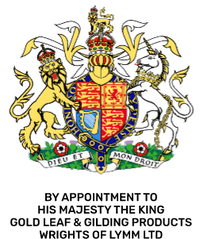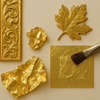Gold Leaf Across the World - Austria
- by Sam Wozniak
Gold Leaf in Austria: A Shimmering Legacy of Art, Architecture, and Restoration
Few countries capture the splendour and sophistication of gold leaf artistry quite like Austria. From the radiant interiors of Baroque churches to the elegant façades of Vienna’s historic palaces, gilding — the meticulous art of applying goldleaf to surfaces — has been a defining feature of Austrian craftsmanship for centuries. Whether in 24 carat or 23.5 carat form, gold leaf has symbolized power, devotion, and beauty throughout Austrian history, and its influence continues today in restoration, architecture, and contemporary art.
This article explores the fascinating journey of gold leaf across Austria — tracing its origins, monumental uses, technical traditions, and modern revival.
The Origins of Gold Leaf in Austrian Art
The use of goldleaf in Austria dates back to the Middle Ages, when monasteries and churches flourished as centres of artistic production. Illuminated manuscripts, icons, and altarpieces were commonly adorned with thin sheets of 24 carat gold leaf to symbolize divine light and heavenly purity. These early gilded works often combined religious devotion with the highest levels of technical craftsmanship.
By the 13th and 14th centuries, Austrian artisans had perfected various gilding techniques — such as water gilding and oil gilding — which allowed for smooth, reflective surfaces or matte finishes depending on the desired effect. Gold leaf became an essential material for religious art, signifying holiness and eternity, while simultaneously reflecting the wealth and power of the Church and the Habsburg monarchy.
The Baroque Era: Monumental Gilding in Austria
The 17th and 18th centuries marked the height of Austria’s monumental gilding tradition. This period coincided with the Baroque and Rococo movements, when art and architecture were characterized by opulence, emotion, and grandeur. Churches, palaces, and public buildings across the Habsburg Empire were adorned with intricate gold leaf details to impress and inspire.
Gilded Churches and Palaces
Vienna, Salzburg, and Melk became epicenters of Baroque gilding. The Melk Abbey, one of Austria’s most famous monastic complexes, showcases an interior drenched in gold leaf — from its elaborate altars to its sculptural details. The Karlskirche (St. Charles Church) in Vienna similarly features breath-taking gilded ornamentation, harmonizing marble, stucco, and gold to evoke divine majesty.
In these monumental projects, craftsmen typically used 23.5 carat gold leaf, prized for its durability and slightly warmer tone. The slightly alloyed composition helped resist tarnishing while maintaining the brilliance associated with pure gold. Meanwhile, 24 carat gold leaf — the purest form — was reserved for smaller devotional objects, royal emblems, and delicate artistic applications where maximum lustre was desired.
The Symbolism of Gold in Austrian Baroque Art
Goldleaf during the Baroque period carried symbolic meaning beyond decoration. It represented light, eternity, and the presence of God, transforming interiors into spaces of awe and spiritual transcendence. For the aristocracy, gilded architecture reflected divine right and imperial grandeur. Whether in a cathedral’s altar or a palace ceiling, gold leaf was the ultimate symbol of magnificence.
Rococo Refinement and the Viennese Touch
As the Baroque era gave way to Rococo, gilding in Austria evolved into a more delicate and ornamental form. The Rococo aesthetic emphasized grace, asymmetry, and lightness, with gold leaf used to accentuate pastel colour palettes and intricate stucco work.
In Vienna, the interiors of noble residences such as the Schönbrunn Palace and Belvedere Palace illustrate this refinement. Rooms like the “Mirror Hall” at Schönbrunn sparkle with 23.5 carat gold leaf, which frames mirrors, moldings, and frescoes in soft, glowing warmth. Austrian gilders developed extraordinary expertise during this period, combining artistic sensitivity with technical mastery to achieve seamless, elegant results.
19th-Century Vienna: Gold Leaf in the Age of Modernity
By the 19th century, Austria’s capital had transformed into one of Europe’s great cultural centres. The application of goldleaf shifted from purely religious and aristocratic commissions to include civic and decorative projects. The construction of the Ringstraße in Vienna, lined with monumental public buildings such as the Vienna State Opera and the Austrian Parliament, provided a new stage for gilding.
During this era, architectural gilding adorned domes, reliefs, statues, and decorative panels. Advances in industrial production allowed for more uniform and accessible gold leaf, though traditional artisans continued to produce handcrafted sheets for the most prestigious works.
The late 19th and early 20th centuries also saw gold leaf enter the world of fine art in new and revolutionary ways — thanks to the Vienna Secession movement.
The Secession and Gustav Klimt: The Modern Golden Revolution
No discussion of Austrian gold leaf can overlook Gustav Klimt, the artist who transformed goldleaf into a modern art icon. A leader of the Vienna Secession, Klimt’s work fused symbolism, eroticism, and Byzantine-inspired gold backgrounds into something radically new. His “Golden Phase,” including masterpieces like The Kiss (1907–1908) and Portrait of Adele Bloch-Bauer I (1907), elevated gilding from a traditional craft to a modern statement.
Klimt used 24 carat gold leaf in many of his paintings, layering it to create luminous depth and texture. His innovative technique involved both traditional gilding methods and experimental applications, bridging Austria’s gilded past with the avant-garde modernism of early 20th-century Europe. Through Klimt, goldleaf became not only a symbol of beauty and luxury but also a medium for psychological and emotional expression.
Restoration and Preservation: Keeping Austria’s Golden Heritage Alive
Today, Austria is home to some of the most skilled restoration experts in Europe, many of whom specialize in gold leaf conservation. Centuries-old churches, palaces, and monuments require constant care to preserve their gilded elements against environmental damage and time.
Restoration teams often use traditional materials, including 23.5 carat and 24 carat gold leaf, to ensure authenticity and longevity. Whether repairing a baroque altar in Salzburg or restoring a Klimt frame in Vienna’s Belvedere Museum, these artisans rely on the same handcrafting techniques that have been passed down through generations.
Modern restoration practices in Austria also integrate scientific approaches — using microscopy, pigment analysis, and protective coatings — to stabilize historical goldleaf surfaces while maintaining their natural brilliance. This delicate balance between art and science ensures that Austria’s monumental gilding continues to inspire future generations.
Contemporary Uses of Goldleaf in Austria
While gold leaf’s historical applications dominate Austria’s heritage sites, its modern uses extend far beyond restoration. Contemporary architects, designers, and artists continue to incorporate goldleaf into new projects, often blending tradition with innovation.
In Vienna’s modern art scene, goldleaf is celebrated for its aesthetic and symbolic versatility. Contemporary sculptors and painters use 24 carat gold leaf to evoke themes of spirituality, transformation, and identity. Similarly, luxury interior designers and restorers employ 23.5 carat gold leaf in boutique hotels, concert halls, and even culinary spaces, giving Austria’s design landscape a luminous connection to its artistic roots.
Gold leaf is also used in restorative architectural projects that reinterpret historical motifs for modern contexts. Some Austrian restorations integrate goldleaf details into façades or domes to pay homage to Baroque and Secessionist influences while updating them for the 21st century.
Why Gold Leaf Endures in Austrian Culture
Austria’s enduring relationship with goldleaf is rooted in more than aesthetics — it represents a dialogue between past and present, tradition and innovation. From the monumental gilding of Baroque cathedrals to the psychological shimmer of Klimt’s canvases, gold leaf has symbolized light, divinity, and artistic mastery for over seven centuries.
The use of 24 carat and 23.5 carat gold leaf continues to define Austria’s commitment to craftsmanship and cultural preservation. Each restoration project, each gilded ornament, reflects a nation’s reverence for beauty, history, and artistry. In an age of rapid change, Austria’s gold leaf heritage stands as a gleaming reminder that true artistry never fades — it simply reflects the light of new generations.
Conclusion
From medieval monasteries to the modern museums of Vienna, gold leaf has shaped Austria’s visual and cultural identity like no other material. Whether shimmering in monumental domes or adorning delicate paintings, goldleaf remains a timeless symbol of refinement, faith, and creativity. Through centuries of gilding, restoration, and reinvention, Austria continues to shine — quite literally — as one of the world’s golden hearts of artistic tradition.






